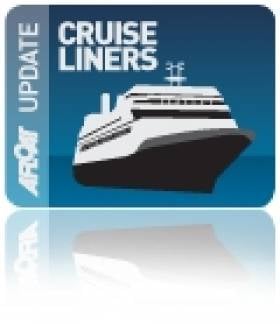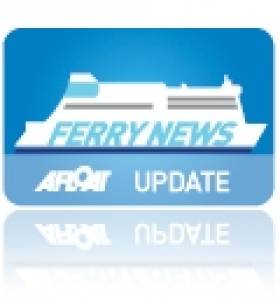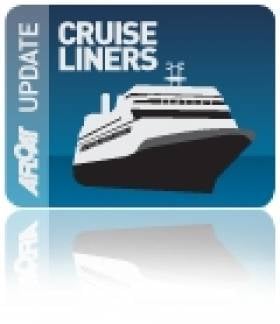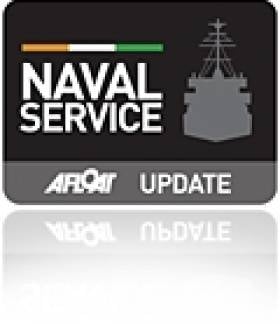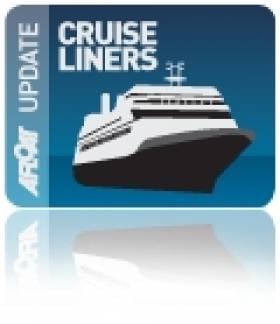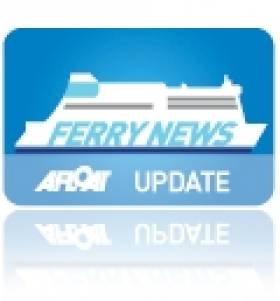Displaying items by tag: Dublin Port
Dun Laoghaire-Holyhead (HSS) High Speed Sailings Close
The core reason to withdraw the HSS on the 120-minute route which is not to re-open until the 2012 season, rests with the high operating costs of the fuel-thirsty fast-ferry which is powered by four gas-turbine engines. In addition the route's generated most of its turnover during the period May-September, leaving the remaining months unsustainable, as such the company wants the route to be seasonal-only in the long-term.

HSS Stena Explorer departs Dun Laoghaire Harbour on her final sailing this season. Photo: Jehan Ashmore
Passengers and freight customers will instead need to use the company's other Dublin Bay route between Dublin Port and Holyhead. The 3 hour 15-minute central corridor route is served by two ro-pax vessels, Stena Adventurer (2004/43,532 grt) and Stena Nordica (2000/24,206 grt) which operate to a year-round schedule, for times click HERE.
What is not certain is the precise date for resumption of Dun Laoghaire-Holyhead services as Stena Line have only indicated that they hope to reopen in April or May nor it is outlined as to what type of fast-craft would operate the route next year.
With today's break in service for at least the next six months, this is the most significant absence of the revolutionary HSS (High Speed Sea Service) 1500 fast-ferry which made her official maiden voyage on the route from Dun Laoghaire on 10th April 1996. The only other notable occasions when the HSS was off-service was for the short spells to allow for annual dry-docking, refit, repairs or when the route in recent years was partially operated by Stena Lynx III.
The 1500 referred to the number of passengers the Stena Explorer could accommodate. She was the first of the three Finish-built HSS 1500 catamaran vehicle capable carrying craft to enter service on three routes from the UK. The next sister completed HSS Stena Discovery entered service in the same year between Harwich-Hook van Holland and the final of the trio HSS Stena Voyager entered the Belfast-Stranraer route in 1997. Several years ago the HSS ceased operating on the Dutch route and the HSS currently serving on the North Channel is due to be replaced by conventional ferries in mid-November as previously reported on Afloat.ie, to read more click HERE.
On the Dun Laoghaire-Holyhead service the HSS enjoyed the boom years, and at its peak there were five daily round trips. From 2006 onwards the routes fortunes began to decline due to the ending of duty-free sales, competition from low-cost airlines, and the increasing cost of fuel.
In order to stave off further losses, a series of cost cutting measures were implemented over the next five years. Firstly the sailing frequency was reduced then the passage times were increased to reduce fuel consumption at the expense of faster crossings. In addition the company resorted to withdrawing the Stena Explorer during the shoulder months surrounding the summer and as previously mentioned these sailings were covered by the Stena Lynx III.
When the Stena Explorer returned for the summer months, the Stena Lynx III switched to her normal high-season spell on Rosslare-Fishguard sailings in tandem with regular route vessel Stena Europe. This year she served as usual on the St. Georges Channel route with the last high-season sailing completed on 4 September.
Stena Lynx III remained initially at Fishguard until making a repositioning voyage to Dun Laoghaire via the Kish Lighthouse last Wednesday. She berthed adjacent to the now disused HSS berth link-span on St. Michaels Wharf. The Tasmanian built craft has spent previous winter layover periods in Dublin and last year in Dun Laoghaire whereas the Stena Explorer is expected to do so in her home port of Holyhead.
At the neighbouring Carlisle Pier, the former terminal where numerous steam-packets, 'mailboats' and the conventional Sealink/British Rail car-ferries served (the last being the Stena Adventurer better known as St. Columba built in 1977) there are plans for a national diaspora museum.
The centrepiece landmark building would form as part of the masterplan proposed by the Dun Laoghaire Harbour Company as part of a concerted effort to offset the reduced role of ferry operations. The masterplan is also to attract cruiseship business amongst other proposals envisaged.
- Dublin Port
- Dun Laoghaire Harbour Company
- Cruise Liners
- HSS Stena Explorer
- Dun LaoghaireHolyhead
- Stena Lynx III
- Stena Line
- Port of Dublin
- Ports and Shipping News
- Ferry news
- Stena Explorer
- HSS
- St.Michaels Wharf
- Dun Laoghaire Harbour News
- Stena Adventurer
- Irish Sea ferry news
- Cruise ships
- Carlisle Pier Dun Laoghaire
- Stena Nordica
- Closure of HSS sailings
- HSS (High Speed Sea Service)
- Dun Laoghaire masterplan
- Diaspora Museum Dun Laoghaire
Cruiseships Head for Cobh in advance of Queen Elizabeth
The 2,500 passenger Jewel of the Seas has a nine-deck centrum which has glass lifts which allows light to flow throughout the spacious and airy ship. Activities range from golf to climbing, a spa and sumptuous restaurants.
When the 2004 built cruiseship docks at the dedicated cruise berth at Cobh in the early hours of tomorrow she will also be sharing the deepwater berth with the 2001 built Silver Whisper. The ultra-luxury vessel accommodates only 388 passengers and is operated by SilverSeas Cruises. To read more about the vessel click HERE.
Both vessels are scheduled to depart Cobh around teatime tomorrow and this will be followed by preparations of the picturesque town which is to welcome the maiden call to Cobh of Queen Elizabeth on Saturday. To read more about the newest vessel of the Cunard Line fleet click HERE. The 2010 built vessel will firstly make an inaugural call to Dublin on Friday prior to the Cobh call which coincides with Cork Harbour Open Day, for event details visit www.corkharbour.ie
Surviving West Country Schooner Evokes Days of Irish Sea Sail Cargo Trade
Bessie Ellen is rigged with eight sails which cover 330 sq m and this would be the only source of power to transport her hold which had a cargo capacity for 150 tons. Her original owner was the North Devon home-skipper Captain John Chichester who named the ketch after two of his daughters. The crew would be limited to between four to six persons, a captain, mate, deckhands and cook.
By the Second World War most of these numerous working cargo sailing ships were being taken over by power-driven vessels. They were becoming increasingly redundant and laid-up rotting away in creeks, fortunately there was sufficient cargo for Bessie Ellen up to 1947.
She was purchased by Danish owners for where she carried a profitable trade in scrap metal, even so sail-power was not enough and she had an engine installed. Trade increased and she was too small to serve her owners Capt. Moller up to the 1970's. In 1983 there were plans to convert the vessel for charter but this fell-through.
Her current owner Nikki Alford brought the vessel in 2000 and over the next three years she was refitted to original rigging specifications and re-emerged in her new career as a sail training vessel. She runs day-long sailing cruises and longer sailing expeditions and educational programmes. Accommodation is for 20 persons in bunks and another 12 is set aside for guests.To read more about the ketch click HERE.
In recent years another West Country traditional sailing vessel the staysail-schooner Kathleen and May made an historic voyage to Dublin in 2008 with a commercial cargo of French wine. This would be the first cargo she conveyed since 1961, also the last year in which the last Arklow owned cargo-carrying schooner the De Wadden would trade, though she was fitted with an engine. The schooner is now preserved in Liverpool, click this LINK.
Katheleen and May made a second delivery to Dublin in 2009 again for Fair Wind Wine and the company (CTMV) also chartered the schooner Etoile de France in advance of St. Patrick's Day. The final CTMV wine cargoes were on board the Bessie Ellen and Notre Dame de Romengol during the last Dublin Docklands Maritime Festival held in 2010. The small French coastal cargo vessel or "gabare" built in 1945 at Camaret, near Brest is classified by the French government as an historic monument.
Also last year the oldest sailing tallship in Europe, the French barque Belem attended the inaugural Hoist the French Sail, French Week in Dublin. The 1896 built Belem was specially chartered in to celebrate the 50th anniversary of Alliance Francaise in Dublin.
Several years ago Belem called to the capital to deliver wine but this was a trade-only publicity exercise prior to the CTMV wine cargoes. Apart from wine she is also associated with Sir Arthur Ernest Guinness of the family brewing dynasty, who owned her as a private 'yacht' under the name of Fantôme II. To read more about the fascinating history of this barque click HERE.
- Dublin Bay
- Dublin Port
- Dublin Docklands Maritime Festival
- Tall Ships
- Fair Wind Wine
- Belem
- Dun Laoghaire Harbour News
- Fantome II
- East Coast skiffs
- Hobblers Challenge
- Rowing news
- St. Michaels Rowing Club
- Irish Sea schooners
- Hoist the Flag French Week Festival
- CTMV
- Bessie Ellen
- West Country ketch
- West Country gaffschooner
- Kathleen and May
- Irish Sea sailing cargo
- Sir Arthur Guinness
- Guinness yachts
- Barque Belem
- Belem Fondation
- Dublin Bay Hobblers
Courtown Harbour Rowing Club took second place in a time of 3:3:19 and third place honours went to Stella Maris Rowing Club with a time of 3:16.00. The hosts of the Hobblers Challenge, St. Michaels Rowing Club based out of the Coal Harbour, passed under the high walls of the East Pier Lighthouse and battery some two minutes later in fourth place.
The annual event (for race-route click HERE) was only re-introduced onto the race calendar last year after a break of several years. The skiffs were launched at the Coal Harbour slipway where they headed over to line-up for the starter's gun opposite the Hobbler's Memorial located on the publicly accessible Eastern Breakwater which is between the Stena Line HSS fast-ferry berth and the Dun Laoghaire Marina.
In attendance to greet the start of the race in memorial of the Dublin Bay hobblers was the RNLB Anna Livia of the local RNLI lifeboat station. The bronze memorial depicts a tower of lifejackets in commemoration of three young Dun Laoghaire hobblers who after piloting and unloading the schooner Jealous of Me in Ringsend, failed to return home.
This occupation was carried out by men also from Ringsend, Dalkey and other harbours and it was the first crew to reach a ship and throw a hook on the deck who would win the business of pilotage and unloading in Dublin Port.
Crews would think nothing of rowing out to the Kish Bank on the hope of spotting a ship. If they waited offshore and no passing trade appeared along the East Coast the craft doubled as a bed if it became too late to row home. The craft were much larger and heavier compared to the present day skiff and it is in these oarstrokes that the Hobblers Challenge follows the original race of the hobblers during the 18th and 19th centuries.
It was apt that on the same day of this year's Hobblers Challenge, the 107-year-old ketch Bessie Ellen, a former cargo-carrying vessel that represented one of the last such sail-trading ships operating in the Irish Sea, was making a passage to the east of the Kish Bank.
To read more about the un-manned Kish Lighthouse click this HERE, and for the 150 cargo tons capacity ketch built in 1904 click HERE.
- Dublin Port
- Fishing
- Dun Laoghaire Marina
- Dublin Bay News
- Irish Lights
- Dun Laoghaire Harbour
- Kish Bank
- Ferry news
- Stella Maris Rowing Club
- Kish Lighthouse
- East Coast skiffs
- Dun Laoghaire Harbour and news
- Stena Line HSS Dun Laoghaire
- Hobblers Challenge
- Dublin Bay pilots
- Rowing news
- Coal Harbour Dun Laoghaire
- St. Michaels Rowing Club
- Courtown Rowing Club
- St.Patricks Rowing Club
- Ringsend skiff clubs
The 162 gross tonnes tug had served a career of nearly three decades in Dublin Port, after entering service in 1972. Prior to working in Irish waters the 100ft tug spent the previous decade operating in the UK as Appelsider for Lawson-Batey Tugs Ltd who chartered her to Tyne Tugs Ltd. For historical record and photos click HERE.
In 1998 the Dublin Port Company disposed of the Coliemore alongside her running mate Clontarf (1963/178grt) the former Cluain Tarbh, also built from the same Yorkshire shipyard on the banks of the River Humber.
Initially they were towed to Liverpool but they later appeared at Cork Dockyard in 1999. The Clontarf remained there for a year until she was sold to Barcazas Dominicia SA, Santo Domingo in the Dominican Republic. For photo of the tug in far distant waters click HERE. It was intended Coliemore would follow her Caribbean counterpart but her sale fell-through.
The vessel's ownership eventually transferred to Cork Dockyard where her scrap value will pay for her long-term berthing fees. The tug recently made her final short journey under tow from her berth at the former Verolme Cork Dockyard (VCD) to the facilities slipway where work to break-up the vessel began.
Coliemore and her fleet-mates were given the traditional naming theme of Dublin Bay coastal suburbs spelt in Irish. The naming policy was used by the Dublin Ports & Docks Board (DP&DB) which operated the fleet remained until transferred to the Dublin Port Company established in 1997.
The last tugs to carry the traditional names, Ben Eadar (Howth), Cluain Tarbh (Clontarf) and Deilginis (Dalkey) are now up laid-up awaiting to be sold, to read more click HERE.
Between the 14-16th centuries Dalkey Sound became increasingly important as larger vessels with deeper drafts could no longer enter the port in Dublin due to the dangers of constantly shifting sandbanks and swallow channels in Dublin Bay.
The nearest alternative was for vessels to anchor off Dalkey Island and in the relative shelter of Dalkey Sound where cargoes for the capital where transferred to and fro by lighters to the coastline along Dalkey at Coliemore, which became the principle port for Dublin. Some of the cargo was stored temporally in the medieval castles in Dalkey, otherwise it was directly transported by horse and cart across the plateau to the city.
It was not until the 17th century that the issue of accessing the port of Dublin was resolved, with the completion of the harbour walls that enabled shipping to return on a frequent basis. Captain Bligh of the 'Mutiny on the Bounty' completed mapping Dublin Bay in 1803 which became the most accurate chart at the time and this aided to the safety of mariners.
The fortunes of Dublin's shipping trade increased due to the combination of an easier and safer navigational channel and deeper depths along the quaysides. This led to the eventual demise of shipping using Dalkey. The present-day harbour structure at Coliemore Harbour was constructed in 1868 and is home to a humble fleet of recreational boats and a passenger-ferry service to the island.
- Howth
- Dublin Bay
- Dublin Port
- Clontarf
- Dublin Port Company
- dalkey
- coliemore harbour
- Dalkey Island
- Port of Dublin
- Ports and Shipping News
- Cork Harbour News
- Verolme Cork Dockyard
- VCD
- Dalkey Sound
- Mutiny on the Bounty
- Dublin Port Tugs
- Deilginis
- Captain Bligh
- Dublin port tugs for sale
- Coliemore
- Coliemore tug
- Cork Dockyard
- Cork Dockyard Rushbrooke
- Cluain Tarbh tug
- Ben Eadar tug
- Deilginis tug
- Richard Dunston (Hessle) Yorkshire
- River Humber
- Dublin Ports & Docks Board
- DP & DB
- Cork Dockyard shiprepairers
- Irish shipbuilding
Stena Line to Reduce Dun Laoghaire-Holyhead Service
Stena Line said the fast craft service would operate until 13th September and would then be suspended until the 2012 season. Two conventional ferries will continue to operate year-round on the company's neighbouring route between Dublin Port and Holyhead.
Stena said it hoped to start the service again in April or May although no decision has been made on an exact date.
Area Director for Stena Line's business on the Irish Sea Michael McGrath said: "Despite all our attempts to reduce operating costs over the last few years, it has not been possible to return the route to profitability.
"We regret that this decision will have an impact amongst our ship's personnel and our port operations staff in Dun Laoghaire but this is a decision that has to be taken for the benefit of the overall business. We simply cannot continue to sustain these levels of financial losses.
"We will now embark on a period of consultation with our staff and their union representatives to discuss the implications of the proposed changes with them."
Stena says it hope to start the service again in April or May, although no decision has been made on an exact date. It is believed around 53 staff will be affected by the decision.
Three Masterpieces Set to Make an Impression in Dublin
Arcadia caters for the UK market and she is on a 13-night cruise which so far has included calls to North Shields, Tyneside, Invergordon, Shetland Isles, Glasgow, Belfast and Liverpool. After her call to the capital she heads for Cork and finally to St Peter Port, Guernsey.
Readers may note that the vessel is of the same design as of Cunard Line's Queen Victoria, which also called to Dublin in May and Cork. In fact Arcadia was to be given the regal name but the 2005 Italian built vessel was transferred from Cunard Line to P&O Cruises, which are under control of US-owned cruise giant Carnival Corporation.
Notable external features of the Arcadia are glass-fronted lifts, two pools, one with a skydome and an interior that is brimming with an art collection consisting of over 3,000 works. She has many facilities such as a three-tier palladium theatre, an intimate 30-seater cinema and gymnasium with an ocean view to inspire those exercising at sea. She was constructed in just twenty months by the Fincantieri shipyard, just outside Venice.
Likewise Eurodam has an extensive art collection theme that is based on the Dutch master's 'Golden Age' including "The Nightwatch, Two Minutes Later", a contemporary re-interpretation of Rembrandt's famous painting. In addition there are 17th-century watercolour maps by famed cartographer Johannes Vingboons.
Passengers on the 11-decked Signature-class can also enjoy the Pan-Asian restaurant and lounge surrounded by panoramic views, an explorer's lounge bar, an Italian restaurant adjacent to the lido, jewellery boutique, atrium bar, show lounge and a photographic and imaging-centre.
Last but not least to dock around lunchtime will be the 30,000 tonnes Ocean Princess, operated by Princess Cruises, another subsidiary of the Carnival Corporation. The 680-passenger / 181 m long vessel may be the smallest of tomorrow's callers and within the Princess Cruises fleet, but the former Tahitian Princess, which underwent an extensive dry-docking in Singapore last winter is well equipped with facilities.
She has a cabaret lounge, club restaurant and bar, casino bar, main pool and spa, steakhouse restaurant, panorama buffet, an Italian restaurant and the Tahitian Lounge. To see the work conducted at the dry-dock, you can view a slideshow by clicking HERE and to see the work in a completed state which also applied to her sister Pacific Princess, watch this VIDEO.
- Dublin Port
- port of Cork
- Dublin Bay News
- Princess Cruises
- P&O Cruises
- Cruiseships
- Port of Dublin
- Ports and Shipping News
- Cunard Line
- Dublin Port news
- Holland America Line
- queen victoria
- Fincantieri Shipyard
- Port of Dublin news
- Arcadia
- Eurodam
- Ocean Princess
- Irish cruiseship ports ofcall
- Dutch masters
- Rembrandt
- Onboard Art Collection
- Johannes Vingboons
Naval Service OPV On Visit to Russia and Baltic States
Since Tuesday the offshore patrol vessel (OPV) has been berthed in the Baltic city of St. Petersburg. Her naval officers laid a wreath at the Piskarevskoye Memorial Cemetery. Also visited was the Central Naval Museum and the naval cruiser Aurora, where one of the first incidents of the 'October' Russian revolution took place in 1917.
Irish Ambassador to Russia Philip McDonagh boarded the L.E. Roisin yesterday to highlight Irish-Russian bi-lateral relationships and co-operation between the two countries in areas of economic, culture, education and tourism. In the first-half of 2010 bi-lateral trade with Russia was up 66% and St. Petersburg is the most important economic centre after Moscow.
The trade mission follows last year's visit of president Mary McAleese who became the first Irish head of state to visit Russia. On her visit which included St. Petersburg, she signed a protocol on partnership and co-operation between the Russian city and Dublin during the third St. Petersburg International Innovation Forum.
In March of this year representatives from St. Petersburg took part in the Russian Culture Festival in Dublin. Three months later in July, the Irish capital was visited by the Russian Naval destroyer Admiral Chabanenko (650), the flagship of the countries Northern Fleet. For more on that visit of the Udaloy –II class destroyer click HERE.
L.E. Roisin is not the first Irish Naval Service vessel to visit the Russian Federation as this accolade goes to the flagship L.E. Eithne (P31) which called to St. Petersburg in 2003.
- Irish Naval Service
- Dublin Port
- naval service
- Ports and Shipping News
- LE Eithne
- Naval Visits
- Navy News
- Irish navy news
- L.E. Roisin
- LE Roisin
- Irish OPV vessels
- St. Petersburg trade mission
- IrishRussian trade
- Irish Ambassador to Russia
- President Maru McAleese
- Irish trade delegation to Russia
- Lt Cdr Peter Twomey
- Philip McDonagh
- Adi Roche
- Chernobyl Children's Project
Clipper Cruiseship Calls In for Fish & Chips
According to her schedule the Clipper Odyssey has since made several calls to include Waterford, Cobh and along the stunning scenery of the western seaboard with anchorage calls off the Great Blasket Islands, Dingle.
Yesterday the 5,218 tonnes vessel operated by Clipper Cruiuses had also called to Inishmore of the Aran Islands. Otherwise the 120 passenger cruiseship is normally found serving in the Pacific Ocean from New Zealand to the Russian Far-East. She is due to depart Co. Donegal this evening bound for Portrush.
As for the 226-passenger Le Diamant she is a frequent caller not just to Dublin, she had arrived from Penzance. The 8,282 tonnes vessel is run by Marseilles based Ponant Cruises and the twin-funnelled vessel is due to depart this evening for Fishguard.
First Heysham-Max Newbuild Launched for Seatruck Ferries
The quartet of Heysham-Max class vessels are the largest ever vessels built to operate from the Cumbrian port which has determined the length of the new ships. Despite the restrictions imposed by the dimensions of the port, the optimum cargo-load of the newbuilds were achieved by positioning the deckhouse forward so to guarantee un-hampered loading of the upper decks.
Propulsion is from two MAN 7L48/60CR main engines of 2 x 8,000kW providing 21 knots. The powerplant is designed to meet rigorous emission and fuel consumption demands, according to FSG managing director Peter Sierk.




























